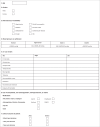A 60% crisis: Mortality and hypertension-driven intracranial haemorrhage at a South African tertiary hospital
- PMID: 40951610
- PMCID: PMC12424030
- DOI: 10.4102/jcmsa.v3i1.202
A 60% crisis: Mortality and hypertension-driven intracranial haemorrhage at a South African tertiary hospital
Abstract
Background: Spontaneous intracranial haemorrhage (ICH) is a significant cause of morbidity and mortality worldwide, with a disproportionate burden in low- and middle-income countries. Data on ICH in South Africa are limited, hindering targeted intervention efforts.
Methods: A retrospective, descriptive study was conducted at Tygerberg Hospital, Cape Town, reviewing records of patients with confirmed spontaneous ICH based on computed tomography imaging from 01 January 2021 to 31 December 2022. Demographics, risk factors, clinical presentation, imaging findings and outcomes were analysed.
Results: Of the 162 eligible cases, 53.09% were male, with a mean age of 51.81 years (standard deviation: 11.88). Hypertension was the most prevalent risk factor (87.04%), with 84.57% presenting with grade 2 hypertension on admission. Basal ganglia involvement was the most common ICH location (55.56%). Complications were frequent, with 79.82% showing intraventricular extension. The 3-month and 1-year mortality rates were 59.88% and 60.49%, respectively. Only 57.41% of hypertensive patients were on antihypertensive medication prior to ICH.
Conclusion: This study highlights the significant burden of spontaneous ICH in a South African tertiary hospital setting, characterised by a younger age of onset and high prevalence of modifiable risk factors, particularly uncontrolled hypertension. These findings underscore the urgent need for enhanced hypertension management and targeted primary prevention strategies to reduce the ICH burden, providing valuable data to inform public health interventions in resource-limited settings.
Contribution: This study provides data on spontaneous intracranial hemorrhage (ICH) in a South African tertiary hospital, identifying a high mortality rate and the prevalence of uncontrolled hypertension in a younger population. The findings address a key data scarcity in low- and middle-income countries and promote the development of tailored prevention and management initiatives, which are consistent with the journal's emphasis on regionally appropriate, evidence-based healthcare interventions.
Keywords: CT scan results; age; blood pressure on admission; clinical outcome of patient; gender; risk factors and comorbidities; use of antiplatelet and anticoagulation medication.
© 2025. The Authors.
Conflict of interest statement
The authors declare that they have no financial or personal relationships that may have inappropriately influenced them in writing this article. The author, S.L., serves as an editorial board member of this journal. S.L. has no other competing interests to declare.
Figures
References
LinkOut - more resources
Full Text Sources




